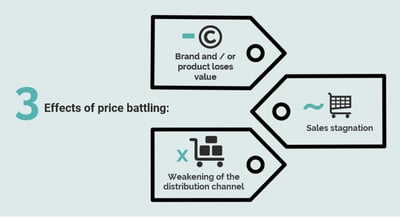Price management gets much more challenging as you diversify your mix of sales channels into your own web shop(s), marketplaces, social media channels or reseller web shop(s). You might ask yourself:

In the world of multichannel pricing, it is key to constantly test, monitor and optimize prices for each sales channel. The goal, for both online retailers (selling B2C) and manufacturers and brands (selling Direct-to-Consumer / D2C) pricing, is to cover your costs, stay competitive, create a value perception for customers, and ultimately, make a profit. However, the strategies to get there are various. Let’s look at some factors to consider when making (multichannel) pricing decisions.
Calculate production costs, or when you are not the manufacturer, your purchase price, distribution and overhead costs, which are all mainly related to the nature of the product.
When selling on marketplaces, you need to consider fees. For instance, when selling a product on Amazon, referral fees need to be paid.
Be aware that the Amazon fees are a percentage of the total retail sales price, included VAT. For example:

Referral fees are typically a percentage of the sales price (usually 15% or less), depending on the product category.
Winning the buy box on marketplaces is not only depending on your price point. But it is still one of the most important criterion! If your seller performance is higher than your competition, you may be able to raise your price and still get your share of the Buy Box.
Next to price, several criteria have a huge effect on winning the buy box on Amazon, such as:
The Buy Box price is not always the lowest price on Amazon.
Amazon rewards the Buy Box to what it deems as best buying options for its customers, not necessarily the cheapest.
Do you want to learn more about how eCommerce search & recommendation engines work? Download our e-book about this topic.
As a manufacturer, it is tough to find a balance between own eCommerce stores and wholesalers and retailers. The number one rule is, always keep the customer in mind. Maintain stability across all sales channels to find a way around any price competition between wholesalers, retailers, and manufacturers. Therewith, you create a common goal.
A common conflict is a so-called multiple channel conflict with a consequence of a price battle. This occurs when a manufacturer has at least two channels competing for sales of the same brands/products.
A manufacturer may be selling their products direct-to-consumer (D2C), while also selling to a wholesaler/retailer. This creates conflict because the manufacturer and retailer may be selling the products to the same markets, but at different prices.

3 ways to make price battles less painful:
![]() Offer exclusive products
Offer exclusive products
Based on your competitor’s analysis you can introduce products that fit unsaturated segments or, when manufacturer, provide a unique product, only available on the brands’ website. Create buzz, build demand and show off your brand!
![]() Offer product Giveaways
Offer product Giveaways
Add value by including an extra product. For example, the Apple gift card.
![]() Offer bundles & Kits
Offer bundles & Kits
Grow sales by helping customers getting more out of your products. Bundling products allows you to discount, without the appearance of discount.
As a brand and/or manufacturer, your products are likely sold across a wide variety of channels—not all authorized or reputable.
It’s easier than ever before for unknown parties to buy your products and resell them online. They can charge whatever they want, as they are not part of a formal distribution channel (grey market).
SiteLucent can help your team save hours of time looking through eCommerce sites or online advertisements to see whether your resellers are following the agreed-upon MAP policy and search for possible violations.

A Minimum Advertised Price (MAP) Policy is an agreement between brand or manufacturer with authorized vendors.
MAP monitoring is the routine process of reviewing the prices of your online retailers across all marketplaces to identify MAP compliance.
3 Benefits of MAP monitoring are:
![]() You can protect your reputations and margins;
You can protect your reputations and margins;
![]() It will show you each of your product’s prices, who is selling that product, and where that product is being sold;
It will show you each of your product’s prices, who is selling that product, and where that product is being sold;
![]() You can contact any non-compliant or unauthorized seller and request corrective action—in some cases, even turning unauthorized sellers into authorized ones.
You can contact any non-compliant or unauthorized seller and request corrective action—in some cases, even turning unauthorized sellers into authorized ones.
Base your pricing decisions and strategy on your competitor’s analysis. Find answers to questions such as:
![]() You may want your prices to be relatively close to your competition, for instance by using dynamic pricing, as too high or too low will affect sales.
You may want your prices to be relatively close to your competition, for instance by using dynamic pricing, as too high or too low will affect sales.
![]() By always having your prices at rock-bottom prices, you’ll reduce your profit and customers may perceive your product quality to be low. Choose a pricing strategy that aligns with your brand and value proposition.
By always having your prices at rock-bottom prices, you’ll reduce your profit and customers may perceive your product quality to be low. Choose a pricing strategy that aligns with your brand and value proposition.
![]() Who are your competitors and how do you want to be ‘seen’ against them? What is your customer target group and how much are they willing to pay? For instance, some type of customers value brand personality, convenience or speed of shopping online, more than the price.
Who are your competitors and how do you want to be ‘seen’ against them? What is your customer target group and how much are they willing to pay? For instance, some type of customers value brand personality, convenience or speed of shopping online, more than the price.
![]() When selling high quality or luxury products, your pricing should likely be higher to communicate the value you provide, whereas with other products you need to keep your margins small to get as many people on board as possible.
When selling high quality or luxury products, your pricing should likely be higher to communicate the value you provide, whereas with other products you need to keep your margins small to get as many people on board as possible.
Is your complete product portfolio available online, at the stores of your customer's choice? At what price points and, when on marketplaces, who 'won' the buy box? Use SiteLucent’s ‘Products Listing & Pricing’ dashboard to get an overview, zoom in to detailed product level, and proceed to action.
We are here to help you get the data and insights you need. Sign up for free and get started or contact us to discuss how we can help!
+31-4-02065510
info@sitelucent.com
© 2021 - SiteLucent | Privacy policy | Terms of use